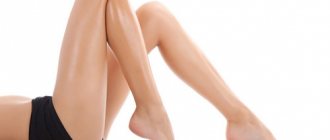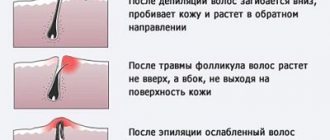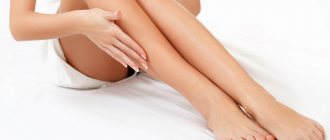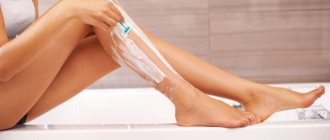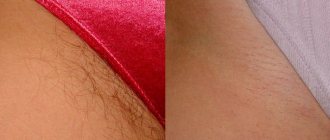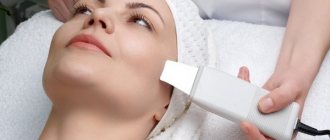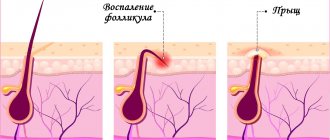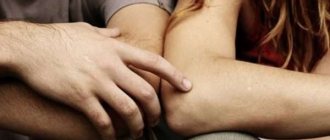BRIEFLY ABOUT THE PROCEDURE
To remove unaesthetic hair, depilation is often used.
It consists of removing hair from the surface of the skin. In this case, the hair follicles are not affected. And after a short time the problem returns. If you resort to hair removal, you can forget about the problem for about a month. This method acts deeper and allows you to get rid of hair along with the follicles. If the second path is chosen (removal with wax, melted sugar or epilator), the damage affects the inner layers. Microtraumas form in areas where hair grows. If a product from the sebaceous glands gets into the wound or, in a particularly unpleasant case, an infection, the problem becomes more acute.
How to prevent acne from occurring
- It is necessary to observe the correct technique: with a machine, hairs are shaved off according to hair growth, chemical cream cannot be kept on for longer than the specified time, when waxing, hairs are pulled out against hair growth, when sugaring according to hair growth.
- All personal care items should only be used by one person.
- To prevent acne from appearing after the depilation procedure, you must follow the rules of skin care.
- For the first 2–3 days, it is advisable to wear loose clothing made from natural fabrics.
- You should not frequently touch the epilated area with your hands for the first couple of days.
- After waxing, mechanical or sugar depilation, it is recommended to scrub the skin after 5 days to reduce the risk of ingrown hairs, which also cause inflammation.
- After the session, you should not use products containing alcohol.
- To prevent acne from appearing on sensitive skin, it should be treated in advance with antiseptic anti-inflammatory agents.
Why does irritation occur?
- After shaving. For women - on the legs, armpits, in the bikini area, and for men - on the face.
- After hair removal with depilatory creams.
- After using wax or sugar paste.
If after such procedures you have acne, it means that you urgently need to find the cause and a way to combat it. It is especially unpleasant when such “joy” settles on the face, because the legs and other parts of the body can still be hidden from prying eyes, but the face cannot.
Sometimes the cause of acne can be ingrown hairs - a common consequence of depilation. As a result of shaving or pulling out a hair against its growth, it (the hair) becomes curved and begins to grow in a different direction, i.e. under the skin. A purulent inflammation occurs at this site, and the deeper the hair grows, the more difficult it is to cure this inflammation.
Another reason is an infection in the pores or hair follicles. This can happen if you depilate with dirty hands, an old razor, or poor-quality wax. The infection gets under the skin, local infection begins, and, as a result, nasty purulent pimples.
Let's talk about sugaring
This procedure is a process aimed at removing unwanted hair from different parts of the body using a sugar paste. The presented procedure is in great demand. It can be carried out both in specialized salons and at home. Those who choose the second option especially often experience the consequences of sugaring.
The essence of the presented procedure is as follows: a paste is prepared from sugar, lemon juice and water, the resulting mixture is applied to the desired area, when the mass hardens on the body, it is removed along with the hair. Such a cosmetic procedure as sugaring has its own nuances:
- It is important to cook the pasta to the desired consistency. If you undercook or overcook it, you can hardly hope for a perfect result.
- Hairs of a certain length can be used for this type of depilation - no more than 5 mm.
- If the paste is frozen, you can use the microwave to warm it up.
- You can't do without peeling if you don't want to deal with ingrown hairs later.
The main advantage of sugaring is the ability to enjoy smooth and velvety skin for a long time. The main disadvantage of sugaring is the pain that occurs when the dried mixture is removed from the hair. This procedure is even more painful than waxing.
Particularly severe pain can be felt if you remove hair from the genital area and armpits. Plus, if the rules of the cosmetic procedure are not followed, white pimples may appear after sugaring in the bikini area. Many people think that the natural composition of the mixture cannot cause allergies or irritation. But that's not true. The skin can react to both sugar and lemon.
MANIFESTATION OF CONSEQUENCES
Regardless of skin type, amount of unwanted hair, or method of removing it, signs of irritation look like this:
- increased skin dryness;
- possible peeling;
- red dots;
- large areas of redness;
- ingrown hairs and the appearance of pustules.
Don't worry right away. After 3 hours, the redness should go away. In the case of particularly sensitive skin, the process may take a couple of days. If during this time the symptoms do not disappear, but, on the contrary, worsen, immediately go to see a specialist. There is no need to waste precious time on treatment at home.
If, despite all efforts and prevention, skin irritation occurs and causes great inconvenience, then simple tips will help save the situation. Those who perform depilation and hair removal at home need to know them especially. A quick response can solve the problem in a short time and alleviate the skin condition. There are various substances that can relieve painful manifestations. These can be medications, caring creams, folk recipes.
We suggest you read: Pills for hair growth after chemotherapy
SPECIAL PRODUCTS They can be purchased at a pharmacy or cosmetics store and used at home. They will quickly relieve your skin condition.
- Antiseptic ointments.
- Baby powder.
- Solutions with levomycin or chlorhexidine. It is recommended to treat the affected areas with epilation 3 times a day until the symptoms disappear. Usually 5 days is enough.
- Medicines to combat burns. A spray with panthenol gives a good effect. After exposure, excess is removed with a special napkin.
- Hydrogen peroxide solution. Treat the skin with a damp cotton swab, and then apply a moisturizer.
- Baby cream can relieve irritation and stop the inflammatory process. It is rubbed into the problem area with light movements.
- After shaving gel or a special cream after depilation can remove all unpleasant manifestations.
RECIPES FROM THE PEOPLE'S PIGGY BANK It happens that hair removal has been carried out, but there are no suitable preparations for subsequent care at hand. You can look for the necessary substances at home and prepare medicinal formulations from what you have on hand:
- Potato. Peel a small root vegetable and chop it on a fine grater. The prepared paste is applied to the irritated area for 10 minutes. Afterwards, wash off with cool water and lubricate with baby cream.
- Aloe. The plant leaf needs to be washed, the side spines cut off, and divided into two parts. They are applied to the skin. Action time: 30 minutes. Then rinse with water and apply a care composition.
- Turmeric. From 2 tbsp. l. product and warm water prepare a paste. It is applied to the area affected by hair removal. After 20 minutes, the residues are removed with water and a kefir mask is made.
- Tea tree oil. For 1 tbsp. l. 2-3 drops of the drug are added to olive oil. This mixture has an anti-inflammatory, antibacterial and healing effect. Use it as a care composition, allow it to absorb, and remove the residue with a clean napkin. Eucalyptus oil also works.
- Medicinal herbs. Lotions made from decoctions of chamomile, calendula, celandine, and string can quickly remove irritation from depilation. They are done several times a day. You can freeze ice cubes from herbal infusions and wipe the skin. This also brings relief.
Getting rid of excess hair at home is not difficult if you know all the rules of the procedure. It is more difficult to cope with the possible consequences. But here, too, there are many ways to relieve the effects of depilation. Use only quality products. For post-hair removal care, choose creams and lotions from the children's series. They undergo strict control and minimize the risk of negative effects on the skin. This is especially important if a problem occurs.
The information published on this site is for reference only. Before using it in practice, be sure to consult your doctor.
Preparing for laser hair removal
How to save yourself from unnecessary consequences?
Laser hair removal is a complex process that involves treating the skin with a high-frequency light pulse called a laser. There is a list of requirements that must be met before the procedure. For example, you should not sunbathe before the session. When exposed to sunlight, our skin begins to secrete melanin. If by the time of the procedure there is too much of it, that is, the skin is tanned, then burns are possible. There are many photos and videos on the Internet where you can see this effect. It is also recommended to remove hair on the treated area only with a razor, since some depilation methods can lead to ingrown hairs and the laser hair removal procedure will be ineffective.
If you are sick with the flu, a runny nose, or your herpes has worsened, it is better to postpone the procedure until you have fully recovered. The procedure is also prohibited for pregnant and lactating women.
Causes of irritation
Getting rid of unwanted hair without getting irritated is quite problematic. And there are several reasons for this. At home, the risk is greater.
- Representatives with sensitive fair skin are especially affected.
- When using a razor, even with the most careful handling, injury to the epidermis occurs.
- If you are a beginner and decided to do this for the first time, then tolerance may improve after 2-3 sessions.
- A possible allergic reaction to the components of the hair removal product may result in severe redness and itching. To avoid this, it is worth testing in a small area.
- Expired wax or depilatory cream can cause big problems. It is important to always check the expiration date.
- Neglecting the care procedure after hair removal increases the likelihood of unpleasant consequences.
- A low pain threshold will require a local anesthetic. When epilating mechanically, it is worth getting a cooling attachment for the device.
- Lack of experience and knowledge of proper procedure at home can lead to irritation.
We invite you to read: Alopecia areata: treatment with drugs, salon and folk methods
Every woman is fully capable of reducing the risk of undesirable consequences of depilation. When performing, follow the rules, prepare the skin for the procedure, use caring creams. For particularly problematic cases, it is worth purchasing medications for use at home.
Most women depilate at home using a razor, various waxes and creams. Unfortunately, any of these methods can cause inflammation in the skin in the area where depilation was performed. Such irritation after depilation on the face, legs, arms or intimate parts of the body can be temporary or remain for a long time. In this case, the woman will have to forget about decorative cosmetics, short skirts and open swimsuits for a while.
Although irritation after waxing or any similar procedure is quite common and normal. The cause is damage to the nerve endings located near the fatty ducts to which the hair follicles are attached. During the process of shaving or pulling out hairs, the nerve endings are irritated, and the released fat contributes to inflammation.
According to professionals, inflammation on the skin after depilation is a completely adequate reaction of the body. This is due, first of all, to the partial removal of the upper layers of the epidermis along with the hair, as well as to the stress that the skin experiences during the first depilation session. All this ultimately leads to the discovery of multiple red spots, inflammations and other “surprises” on the body.
Negative results of hair removal and ways to get rid of them
The consequences after hair removal are expressed in a feeling of tightness, dryness of the skin, and sometimes itching, tingling and a slight burning sensation may occur. In addition, external irritation manifests itself in redness, age spots, and pimples.
The problem of red and black dots
Almost every person who has undergone hair removal has encountered consequences in the form of red or black dots. After the first hair removal, this is considered normal; in subsequent times, this phenomenon decreases or disappears altogether. The spots are the result of damage to the epidermis and hair follicle, because after the procedure, droplets of blood and ichor are released from the pores, which dry out and form crusts. New epidermal cells must grow underneath them, after which the appearance of the skin will return to its previous state. In this case, no special care is required; the main thing is not to tear off the crusts ahead of time and not allow them to dry out.
Red dots after hair removal are crusts formed from drops of blood and ichor
To combat black and red dots the following will help:
- cooling cream;
- emollient oil, in particular for baby skin care;
- baby powder;
- rubbing with infusion of medicinal plants.
Under no circumstances should alcohol be used to wipe areas of the body covered with red dots after hair removal. Alcohol has a drying effect, so after it the feeling of burning and tightness will only worsen.
The appearance of acne after hair removal
During the hair removal process, nerve fibers, of which there are many in the epidermis, can be injured. As a result, inflammation occurs, which develops into the accumulation of pus inside the hair follicle, and acne appears. This is a very common occurrence for those with particularly sensitive skin, as well as when epilating the bikini area and armpits, because the epidermis there is very thin and has many nerve endings.
Most often, after hair removal, acne appears in the armpit area, as the skin there is very sensitive and thin.
Also, the appearance of ulcers after hair removal can be provoked by a banal neglect of treating equipment with antiseptic drugs or an insufficient amount of them. Through microdamages of the skin, invisible to the naked eye, infection penetrates and very quickly causes suppuration. Allergies can also be expressed in the form of acne on epilated areas of the body. If this problem occurs, it is important to begin treatment immediately:
- medications: ointment with antibiotics, creams with anti-inflammatory and healing effects, powders, liquid antiseptic solutions;
- traditional medicine: lotions with the juice of beneficial plants, decoctions of medicinal herbs, essential oils.
Inflammatory processes on the skin
Inflammation after hair removal is expressed in redness and swelling. For the most part, such phenomena are temporary, go away on their own and do not require special treatment. The intensity of inflammatory processes depends on the density, thickness of the hair and the depth of its roots. Any removal of vegetation is an intervention in the body, the response of which is inflammation.
Inflamed skin after epilation has a reddened appearance, and also feels tight and itchy
If swelling and redness are severe and do not go away for five to seven days, then you need to seek help in treatment from a dermatologist. In the first hours and days after hair removal, cooling creams or sprays, as well as emollients and antiseptics without the addition of ethanol, for example: tonic lotions, aftershave gels, will help relieve inflammation.
Folliculitis
Folliculitis is inflammation and suppuration of the hair follicle, a fairly common occurrence after hair removal. For a number of reasons, pathogenic bacteria can enter the hair follicle and cause infection. It develops especially quickly in the bikini area and armpits, because in these areas there is increased sweating and limited supply of fresh air. Experts strongly recommend wearing loose clothing and underwear made from natural fabrics, since the factors that provoke folliculitis are friction and poor ventilation due to synthetic fabrics.
Folliculitis develops when pathogenic bacteria and infection enter the follicles after hair removal
It is strictly forbidden to squeeze out pimples with folliculitis with your hands, as this spreads the infection over a large area and delays treatment.
The disease most often begins with redness of the skin around the follicle after epilation, and a moderate feeling of pain when pressed. Then the inflammation leads to the appearance of small purulent pimples. If treatment is untimely or incorrect, decay products, blood and lymph accumulate in the affected follicles, resulting in acne thickening, enlarging, and becoming painful. If the inflammation affects the upper layers of the follicles, then over time the pus comes out and a crust forms, in place of which pigmentation may remain for some time.
In difficult situations, pus penetrates deeper into the follicle, causing the formation of itchy nodes reaching a diameter of 1 cm, and the nearby lymph nodes enlarge. Folliculitis can be single or multiple. To get rid of folliculitis, depending on the complexity, treatment with disinfectants, including alcohol-based ones, will be required, as well as the use of ointments and creams containing antibiotics.
Candidiasis after hair removal
Thrush (candidiasis) is very rare as a side effect of deep bikini hair removal. The disease is fungal in nature; for it to penetrate the body, it is enough to reduce the immune response, which can be provoked by multiple factors.
If sanitary rules are violated when epilating a deep bikini, there is a risk of getting thrush.
After hair removal, the causes of thrush may be the following:
- violations of hygiene rules: repeated use of sheets passed from one woman to another, poor sterilization and antiseptic treatment of equipment;
- infection through open micro-cuts of the skin in the immediate vicinity of the vaginal mucosa;
- an allergic reaction to the ingredients of cosmetics for or after hair removal, as a result of which immunity is reduced and a “window” opens for the penetration of the disease.
It is necessary to treat thrush after a visit to the doctor as prescribed, including with local medications.
Bruises
Bleeding and bruising are consequences of hair removal, most often after electrolysis. This complication is not normal; bruising can be caused by the needle getting into the capillary next to it rather than into the hair follicle itself. If you do not stretch the skin when inserting the electrode, you can also damage the surrounding tissue.
Bruising after hair removal may occur if capillaries were damaged during the procedure.
After laser or Elos hair removal, bruises are extremely rare, since these procedures are performed without contact with the skin. Bruises are treated with special blood-absorbing medicinal ointments or creams, which can be purchased at any pharmacy.
The effect of hair removal on a woman's menstrual cycle
Many representatives of the fair sex are interested in the question of whether the procedure will affect the regularity of menstruation. There are very rare cases when women go on the eve of their period for deep bikini hair removal, after which a delay occurs. This happens, but there is no scientific confirmation. Therefore, experts recommend planning such procedures in advance and undergoing them at least a day before the start of menstruation.
Hair removal, especially the first procedure, is a shock to the body, an interference in its natural functioning, so hormonal disruption may occur, and during premenstrual syndrome, hormones are very unstable. Also, an inexperienced specialist can set up laser or broadband light radiation that is too powerful for a person. Each body is very individual and it is impossible to predict the reaction to epilation and the pain from it.
Remedies for skin irritation
Now let's talk about how to remove irritation on the face, legs or bikini area if it is not caused by ingrown hairs. In this case, it either occurs due to infection, or is a consequence of the individual reaction of your skin to rough impact from a razor or other depilatory means.
The following will help you with purulent acne:
- Salicylic acid, which will quickly cope with irritation, kill germs, and make the skin clean.
- Post-depilation cream, spray or ointment: Vagisil, Panthenol, Bepanten, zinc ointment, hydrocortisone ointment, and the like. All of them, in one way or another, effectively cope with skin irritations in a short time. They are easy to use: you need to apply a small amount of cream or ointment after depilation and let it absorb. Some of them have contraindications, so be sure to read the instructions before use.
- Chlorhexidine, hydrogen peroxide - these products will also kill the infection that has entered the pores, and will easily cope with mild irritation.
We suggest you read: Castor oil and hair growth
Anti-irritation products after hair removal
Normally, after hair removal, redness and swelling of the skin are allowed, which disappear within a few days. To make your skin soft, smooth and healthy faster, you need to use various products. Today their range is quite wide; on the shelves of pharmacies and cosmetic stores you can find jars and tubes with a wide price range. In addition, there are folk recipes for use at home.
Pharmacy products
You can buy many medications at the pharmacy to relieve and prevent the unpleasant consequences of hair removal.
Hydrocortisone helps relieve irritation and accelerates skin healing
Medicines:
- Hydrocortisone ointment 1% is applied in a thin layer twice a day; for severe skin lesions, bandages are applied at night. If irritation has not decreased within a week, you should change the product.
- The drug Flotseta in the form of a gel is easy to use. On the first day after hair removal, treat every three hours; on the second and subsequent days, two or three times will be enough.
- Badyaga in the form of biogel or balm is excellent for helping against bruises and spherical seals. The affected areas are treated with the drug two to three times a day, washed off after ten minutes, after which a nourishing cream can be used.
- Bepanten cream or ointment, as well as analogue drugs, fight redness and activate regenerative processes in tissues in case of burns, wounds and suppuration in the follicles.
- Zinc ointment disinfects and dries irritation. Vaseline and zinc oxide in its composition form a microfilm on the skin, under which the damaged epidermis is restored, and new bacteria and infections cannot enter. After using the ointment, you need to soften the skin with cream.
- Lubricating folliculitis with salicylic acid speeds up its healing.
- Therapeutic gel-cream Follivit is designed to prevent ingrown hairs inside the epidermis; the content of plant extracts and salicylic acid blocks itching and inflammation.
- The use of calendula tincture disinfects and soothes inflamed skin.
Cosmetical tools
The cosmetics are intended for use immediately after the hair removal procedure, as well as for daily skin care. These can be specialized products or standard ones intended for everyday care. Cosmetics to get rid of irritation after hair removal:
- Baby cream is sold everywhere. Its application after hair removal will relieve discomfort and improve the condition of the skin.
- Sunscreens and emulsions must be used to prevent burns during laser and hair removal.
- Redlock cream is used in salons and at home, it is designed to slow down the growth of new hair after hair removal, while nourishing and eliminating skin tightness.
- Spraying Aravia Professional Lotion Spray helps slow down the growth of hair and also prevents the appearance of ingrown hairs.
Regular baby cream helps restore skin damaged after hair removal
Specialized cosmetics are easy to use and solve several problems at once, but at the same time their price is quite high, and availability is limited, since they are sold in specialty stores or salons.
Folk recipes
Compositions prepared independently at home can help in skin care after hair removal just as well as store-bought ones. There are the following homemade recipes from available ingredients:
- Soothes irritated skin with a mixture of 10 grams of glycerin and powder from two tablets of acetylsalicylic acid, which must be spread and left for twenty minutes, rinsed off with cool water. This daily mask should be carried out for a week or two.
- Mix two drops of tea tree essential oil and one tablespoon of olive oil, and then rub into irritated areas of the body with gentle movements, leave to soak for half an hour, then do not rinse off, but blot the residue with a napkin. Regular use of oils twice a week will help cope with irritation and make the skin velvety and elastic.
- A prepared decoction of a mixture of dried mint and chamomile flowers (20 grams per 500 ml of boiling water) is used for lotions. A piece of gauze of the appropriate size is completely soaked in the broth and applied to the epilated area for half an hour twice a day. Repeat for ten to fourteen days.
- The healing balm perfectly relieves irritation. To make it, you need to soften three teaspoons of honey and mix with two teaspoons of almond oil and essential oils of mint, lemon and tea tree (three drops of each). Apply a thin layer to the skin in the morning and evening for 1–1.5 hours, then rinse off. The course of treatment should last at least ten days.
A decoction of chamomile flowers helps relieve skin irritation after hair removal at home
PREVENTIVE ACTION
If you take simple steps, you can minimize irritation after waxing at home. These tips relate to skin preparation, the process and what to do afterwards:
- If you are epilating with wax, molten sugar, or an electric device, a bath will help. It will steam the skin, expand the pores and make hair removal easier. It is important to thoroughly blot the surface of the body from water before starting.
- Women with delicate skin can try to get rid of hair using movements in the direction of growth. It will take longer, and the irritation will be less than usual.
- You should not treat the same area of the body several times. This applies to a razor, wax, epilator, special cream, etc. It is better to remove the remaining hairs during depilation another time or remove with tweezers.
- You cannot use a scrub and a washcloth on the first day after the hair removal procedure. And also try to refrain from scratching, so as not to cause even more damage.
- During the first 3 hours you should not take water procedures, and it is better to rinse off the depilatory cream with cool water. This will prevent pores from enlarging and unwanted substances from entering. And you should refrain from visiting the sauna, pool or swimming in open water for two days.
- To protect from sun rays, use moisturizers that do not contain α- and β-hydroxy acids. They can cause irritation and inflammation. In general, it’s better to avoid sunbathing at first. The use of self-tanning is also undesirable.
- A greasy product or caring lotion without alcohol additives will help soothe the skin after hair removal.
Frequently asked questions and their answers
After sugaring, purulent pimples appeared, from a mechanical epilator and shaving never happened, what is the reason?
If pimples appeared after sugaring and were not observed from other procedures, this particular method may not be suitable for you.
Why did pustules appear in an intimate place, although I did not change the hair removal technique and acne had not occurred before?
There may be an infection, you should visit a doctor.
I had difficulty getting rid of acne after waxing and now I’m afraid of any procedures, what if the abscesses appear again, what should I do?
Try the epilator cream for now, the risk of acne from it is minimal.
Instead of a scrub, you can do peeling; products intended for the treatment of acne and pimples are suitable for this.
What to do if acne appears after hair removal? Pimples and purulent inflammations can appear for four reasons
Methods for treating acne after hair removal. When deciding on an hair removal procedure, any woman expects to get smooth and beautiful skin.
Areas of skin with a large number of moles and pimples should be shaved very carefully.
In order to enjoy a smooth body after depilation, and not remove acne and ingrown hairs, it is enough to follow a certain scheme.
I always use a scrub before epilation, but irritation still appears from time to time. I save myself with Elon ointment from the pharmacy. After it, small pimples and redness go away very quickly.
Waxing today is one of the most popular ways to combat the growth of unwanted hair. This method is quite effective, however, many people, especially those with sensitive skin, often experience irritation on the skin after such procedures.
In this article we will look at the possible causes of this side effect and tell you how to relieve irritation after waxing.
Tips and tricks
It is much easier to prevent irritation after depilation of the face, legs or other parts of the body than to treat them for a long time and tediously. For this it is enough:
- maintain hygiene;
- moisturize the skin daily with creams, preferably herbal ones;
- use antiseptic drugs after depilation;
- do not visit baths, swimming pools, saunas during the day;
- do not shower/bath for 2-3 hours;
- When going out into the sun immediately after the procedure, use sunscreen.
Irritation and pustules after hair removal in the bikini area: how to deal with them
If you still see pimples after sugaring in the bikini area, do not be upset or panic. In some cases, this is a feature of the skin that manifests itself despite a variety of tricks. Your task: try to eliminate the pustules that appear after hair removal in the bikini area. Folk remedies can help with this. Here are some of them:
- Chamomile decoction. This flower perfectly “drives away” acne after depilation in the bikini area. The decoction is applied using a tampon several times a day.
- Potato juice. This product is great for speeding up the healing process. It’s not difficult to get juicy potato porridge; just grate the tubers on a fine grater. The resulting mixture should be applied as often as possible.
- Fresh honey. It should be heated and applied to inflamed skin. The ulcers that appear after hair removal in the bikini area will quickly disappear.
Don't you really want to bother with the above products? In this case, you can simply go to the pharmacy and buy an ointment called “Panthenol”. It is designed with one purpose - to treat all types of irritations, including after sugaring. Apply the ointment to problem areas of the skin and enjoy its fast action. All girls, without exception, like her, as she is the first assistant in such a necessary matter.
It is clear that it is much more reasonable to correctly follow the recommendations according to which sugaring should be performed. This can also be said about hot wax depilation. Do not neglect the advice of specialists, remember what folk remedies can help in emergency cases. Of course, beauty requires sacrifices, but they must be reasonable and justified. Ruining your health and spoiling your good mood is not an option for those who value and love themselves. Take care of your beauty!
First signs of irritation after waxing
Irritation after waxing may appear a few minutes after the procedure, or it may make itself felt after a few hours or even the next day. This depends on the degree of skin sensitivity, the level of stress received by the body during depilation, and actions after the session.
The first sign that indicates irritation is a burning sensation or slight tingling sensation in the treated area , which intensifies over time. These symptoms appear before you even see obvious signs of a problem.
The second essential sign of irritation after waxing –
redness of the skin.
It can appear as a single spot, but most often small red dots are formed, abundantly scattered over the treated surface .
Redness is accompanied by itching, which often reaches such a degree that you want to scratch the skin. A little later, in place of the red dots, pustules with a white core may form. People with hypersensitive skin may experience a local increase in body temperature and mild chills.
How to carry out the procedure correctly
Irritation on the skin after removing unwanted vegetation may occur due to non-compliance with the rules for performing procedures. The greatest demand is for waxing, sugaring and laser hair removal. Let's talk about them in more detail.
Waxing
Hair removal with wax is a simple procedure that can be done at home. To minimize irritation:
- the length of the hairs should not be less than 0.5 cm;
- heated wax is applied to the body against hair growth;
- remove the wax plate strictly according to hair growth.
Waxing is considered to be the most painful procedure.
Sugar depilation
Sugaring has recently become one of the most popular body hair removal procedures.
Advantages:
- use of a hypoallergenic mixture (sugar, lemon juice, water);
- suitable for sensitive skin;
- minimal pain;
- no ingrown hairs.
Just knead the paste in your hands for a few seconds until the mixture becomes soft and pliable. Then it is applied to the skin and rolled out for 10 seconds, capturing the desired hairs. The resulting apilation is removed with a sharp movement of the hand according to the hair growth. After the session, the skin is washed with warm water and a moisturizer is applied.
The disadvantage of sugaring is that after 3-4 weeks, unwanted hair appears on the body again.
Laser hair removal is the optimal solution for removing unwanted hair
Laser hair removal is a quick way to get rid of body hair once and for all. The procedure is carried out only in beauty centers and salons; carrying out such manipulation by a private master is highly undesirable.
The laser beam penetrates deeply into the dermis, heating the cells that contain melanin. As a result, the hair follicle is destroyed. The procedure is quite fast. It takes 10 to 15 minutes to remove facial whiskers. Treatment of the bikini area takes 20-25 minutes.
To consolidate the result, experts advise carrying out several similar procedures, explaining this by the fact that a person has follicles that are in the “sleep” phase.
The main condition for successful laser hair removal is the required hair length. They should not be about 1.5-2.5 mm.
Advice from a cosmetologist! Laser hair removal is a reliable way to remove hair from the body. The advantages of the procedure are obvious: minimal pain, long-lasting effect, short session duration, absence of ingrown hairs.
